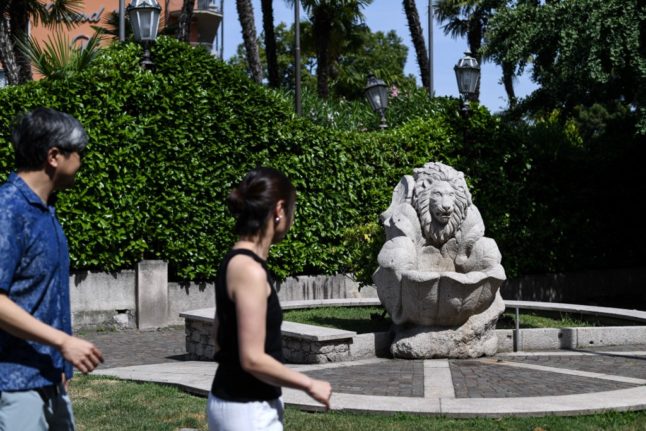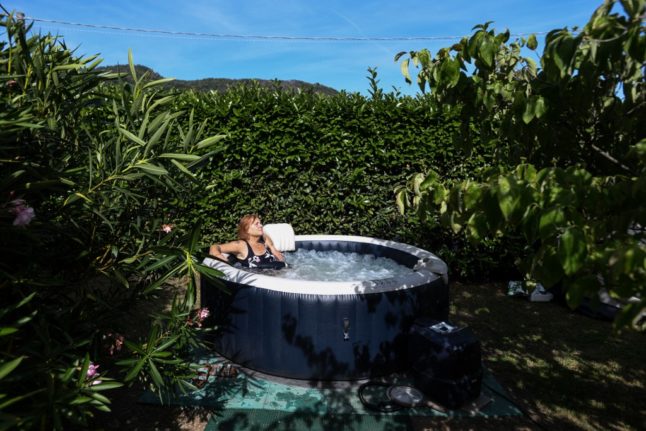Since the middle of June this year, many parts of Italy have been on drought alert, and a ‘state of emergency’ was declared in July in five northern regions: Friuli-Romagna, Friuli-Venezia Giulia, Lombardy, Piedmont and Veneto.
But what this means for people living in or visiting Italy depends on the rules set in each region and municipality, and these vary significantly from place to place.
READ ALSO: Italy’s risotto rice fields decimated by worst drought in decades
While some areas have restricted the use of drinking water, others have switched off city fountains or asked people not to fill up their swimming pools this summer.
If your local comune (town hall) has imposed water use restrictions, notices are usually sent out to residents and you should also be able to see the rules on your local comune’s website.
Here we answer some of the most commonly-asked questions about the water use restrictions in place:
Is there a hosepipe ban?
Hosepipe bans are common in the UK during drought periods, but Italian water restrictions work differently. There is no ban on using hosepipes in particular, but many areas have limited activities such as washing cars or watering the garden that you might normally use a hosepipe for.
For example, in the Veneto region, dozens of towns and comuni including Verona, Villorba and Montebelluna have imposed restrictions on the use of potable water for anything other than domestic and hygienic purposes.
READ ALSO: Historic drought resurfaces World War II bomb in Italy’s River Po
Check local restrictions in your area, but some authorities have specifically forbidden the use of water for watering plants, or only allow them to be watered in the evening.
These rules apply whether you are using a hosepipe, watering can or any other implement.

Is Italy rationing tap water?
Not everywhere in the country. But in some areas, municipal authorities have placed restrictions on the supply of tap water as local supplies threaten to run dry.
This includes hundreds of towns and villages in Piedmont and Lombardy, as well as several comuni in Lunigiana, northern Tuscany.
Such a rule usually means supplies are restricted during the night only, typically between 10pm-7am, but if you have water use restrictions in place in your area check your comune‘s website for full details of what you’re allowed to do and when.
I have a well on my property, can I use water from the well to water the garden?
It’s not uncommon in rural areas for properties to have a well or similar that provides fresh but untreated water. Obviously you shouldn’t drink this as it may not be safe, but many people use it to water gardens.
Unless otherwise stated, water restrictions announced by local authorities for residents usually concern only acqua potabile (drinking water, or tap water) so you can continue to use water from the well.
Watch out for a mention of acqua di pozzo (well water). If your local restrictions mention acqua non trattata (untreated water) that includes all types of water, including water from your well.

Can I fill my swimming pool?
This depends on the level of drought restriction in place in your area, but most parts of Italy now have some restrictions on private swimming pools.
For example, in some parts of Varese you may need to get permission from the water company before filling your pool, while the comune of Florence has a complete ban in place.
And it may also depend on whether you use tap water or water from your own private well.
Tap water use restrictions only apply during the day in some cases: residents of Villorba, near Treviso, are not allowed to use potable water to water gardens, wash vehicles or fill up pools between 6am and 11pm.
In some areas, local municipal swimming pools may be closed.
The bans on filling pools do not appear to apply to businesses, including hotels and resorts, but it’s always best to check the rules with your local town hall.

Can you really be fined for breaking the rules?
Yes. Fines again vary by local authority, but in parts of Veneto and Piedmont, for example, penalties for breaking the rules reportedly range from 25 to 500 euros.
How strictly the rules are enforced is hard to say. But if your area has water restrictions in place, it’s likely that filling the swimming pool, washing the car and watering your lawn will make you unpopular with neighbours who are following the rules – and this could be even more unpleasant than a fine.
What’s the official advice on saving water?
Even in areas where no official restrictions are in place, Italian authorities are asking everyone to make an effort to save water this summer. Guidelines released by government agency ENEA in July include the following advice:
- Turn off taps, and don’t let them drip;
- Limit the amount of tap water used on gardens – install containers to collect and store rainwater to use instead (some areas have more stringent measures in place on gardens)
- Install water-saving equipment;
- Take a shower instead of a bath;
- Repair water leaks;
- Don’t run your washing machine or dishwasher half empty.
We’re happy to answer questions from our members on any aspect of life in Italy. Get in touch at [email protected]



 Please whitelist us to continue reading.
Please whitelist us to continue reading.
Member comments